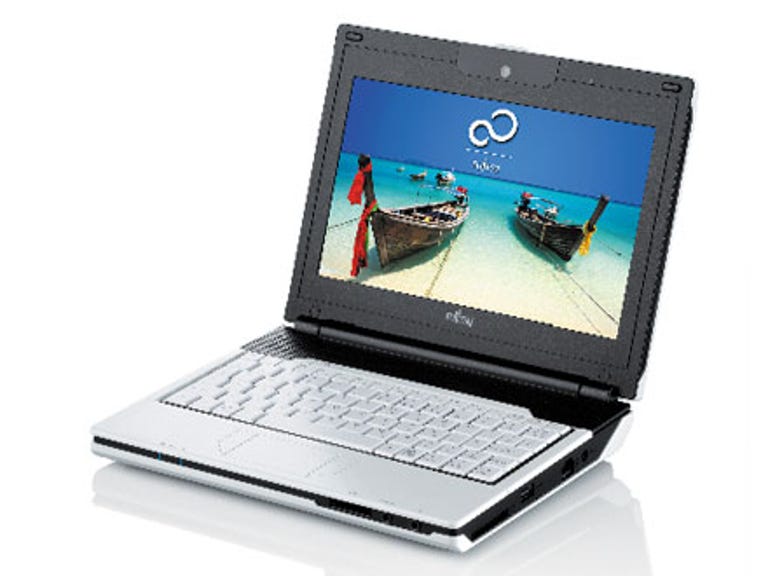 Why You Can Trust CNET
Why You Can Trust CNET Fujitsu M1010 review: Fujitsu M1010
Fujitsu's netbook offering doesn't really differ much in performance, but redeems itself in design. We still wish it was a touch cheaper, though.
Design
At a certain level, the physical dimensions of a netbook don't give designers much to work with. Once you slap an 8.9-inch screen onto the same old components, you don't have a big canvas to work with, although that hasn't stopped some more interesting designs from coming forth, such as the HP Mini 1001TU's whirly pattern.
The Good
The Bad
The Bottom Line
And then there's the Fujitsu M1010. On the surface, the basic M1010 looks much like any other white netbook. Honestly, it's tough not to look at it and think "Tiny older-style Macbook with Fujitsu logo inexplicably on it".
Where the M1010 attempts to differentiate is by offering snap-on covers. The basic unit comes with a transparent cover, which you could snap over a photo, illustration or any other image you'd care to name, while Fujitsu will also offer a variety of coloured covers for an as-yet-undisclosed additional price.
We've got to talk about these things in a purely theoretical sense, however, as our review sample came sans covers at all — not even the transparent one that comes by default. In theory it's an interesting idea at least, but we can't speak to how well it fits or whether it looks good or not. It does make us think, given the white style, that you could put Apple fanboys into fits by using the transparent cover and an Apple logo carefully printed to give the illusion of the long-rumoured Apple netbook. Just a thought, mind you.
In style terms, the M1010 belongs to the same family as HP's Mini Notes and Acer's Aspire One models, in that the touchpad is flanked by the mouse buttons, rather than resting above them. It's very much a personal thing as to whether that's a workable arrangement; we find it annoying as it's non-standard, but tastes vary.
Features
Fujitsu's gone for a radical rethinking of what constitutes a netbook, offering previously unseen combinations of dazzling new CPUs and memory ... no, we're lying, and not very well at that.
Underneath the hood you'll find what could practically be called the recipe for a 2008 netbook, arranged in a mostly predictable order. 1.6Ghz Intel Atom Processor? Check. 1GB RAM, in line with Microsoft's strict XP licensing terms? Double check. 8.9-inch display screen with a maximum resolution of 1,024x600? Triple check. The M1010 comes with a 4,200rpm 60GB hard drive, which gets past the pesky SSD-equipped netbook problem of not having enough space to actually do anything with Windows XP once it's installed and patched. Equally, though, 60GB isn't the largest internal drive we've seen in a netbook. The M1010 only has two USB ports — one on each side of the case — as well as a single ExpressCard slot, VGA port, Ethernet, audio input and output, and a multi-format card reader. It's a decent combination, but again, not exactly an earth-shattering one.
On the software front, Fujitsu has opted to bundle ThinkFree Office, an online-centric office suite. It's certainly in stark contrast to the approach that's seen either OpenOffice.Org or Microsoft Works offered in netbooks to date, but not one that's particularly exciting, either.
Performance
On a physical level, the M1010 works fairly well. It does have the classic problem of 8.9-inch netbooks with supposedly "full" keyboards, in that each key is quite small and thus you'll have a learning curve to overcome before you do away with mistyping gremlins. The chassis itself feels quite solid, and predictably, after a while on the lap you start to feel its heat building up.
On a performance level, the M1010 didn't stun us, but then, no netbook ever does. PCMark05 and 3DMark06 refused to run completely — again, a very common netbook woe — but the component level testing showed very little difference against other hard drive equipped netbook models. Certainly, for the type of single-use portable computing that netbooks are built for, the M1010 performs well enough.
Battery life is always a key concern for netbook buyers, and Fujitsu sells the M1010 with a four-cell, 2200mAh battery. Quite how long that lasts is always dependent on what you use it for; in our video test — running a looped video full-screen — at full screen brightness, we managed to exhaust a fully charged M1010 battery in two hours and 20 minutes, predictably a long way below Fujitsu's claimed four-hour battery life. Running the same test against a range of netbooks revealed very similar battery life for most models, aside from some well-known quality performers such as Asus' Eee 1000H and MSI's U100 Wind. Fujitsu clearly has some confidence in the M1010's build quality, as it backs it up with a two-year warranty, which is unusual in the netbook space.
Fujitsu has at least taken a slightly different pitch in the netbook space; if you can't compete on internal features, make the outsides look pretty. It's a decision that works up to a point, but with an AU$699 price point, it's still a little tough to get excited given that you could get a 10-inch unit for the same kind of price, or a very similarly performing 8.9-inch model for a hundred dollars less.


